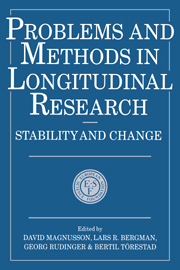Book contents
- Frontmatter
- Contents
- Contributors to this volume
- Foreword
- Preface
- 1 Studying individual development: problems and methods
- 2 Modeling individual and average human growth data from childhood to adulthood
- 3 Intraindividual variability in older adults' depression scores: some implications for developmental theory and longitudinal research
- 4 Now you see it, now you don't – some considerations on multiple regression
- 5 Differential development of health in a life-span perspective
- 6 Assessing change in a cohort-longitudinal study with hierarchical data
- 7 Statistical and conceptual models of ‘turning points’ in developmental processes
- 8 Qualitative analyses of individual differences in intra- individual change: examples from cognitive development
- 9 Application of correspondence analysis to a longitudinal study of cognitive development
- 10 Event-history models in social mobility research
- 11 Behavioral genetic concepts in longitudinal analyses
- 12 Genetic and environmental factors in a developmental perspective
- 13 Structural equation models for studying intellectual development
- 14 Longitudinal studies for discrete data based on latent structure models
- 15 Stability and change in patterns of extrinsic adjustment problems
- Index
4 - Now you see it, now you don't – some considerations on multiple regression
Published online by Cambridge University Press: 27 April 2010
- Frontmatter
- Contents
- Contributors to this volume
- Foreword
- Preface
- 1 Studying individual development: problems and methods
- 2 Modeling individual and average human growth data from childhood to adulthood
- 3 Intraindividual variability in older adults' depression scores: some implications for developmental theory and longitudinal research
- 4 Now you see it, now you don't – some considerations on multiple regression
- 5 Differential development of health in a life-span perspective
- 6 Assessing change in a cohort-longitudinal study with hierarchical data
- 7 Statistical and conceptual models of ‘turning points’ in developmental processes
- 8 Qualitative analyses of individual differences in intra- individual change: examples from cognitive development
- 9 Application of correspondence analysis to a longitudinal study of cognitive development
- 10 Event-history models in social mobility research
- 11 Behavioral genetic concepts in longitudinal analyses
- 12 Genetic and environmental factors in a developmental perspective
- 13 Structural equation models for studying intellectual development
- 14 Longitudinal studies for discrete data based on latent structure models
- 15 Stability and change in patterns of extrinsic adjustment problems
- Index
Summary
There is always a temptation to shrink from the difficult task of grounding identifying assumptions in empirical and theoretical knowledge and to select them instead on grounds of statistical convenience or simplicity. This is a temptation that is worth resisting if we wish to arrive at a real understanding of the phenomena we are studying. In this as in other decisions associated with our statistical methods, it is a snare and a delusion to seek out ‘automatic’ techniques that can be applied without careful consideration or that are neutral with respect to the substance of our theories. It is not enough to learn the etiquette book. The reason (or lack of reason) for its rules must be understood as well.
Herbert A. Simon (1979)STATISTICS AND THE ANALYSIS OF SURVEY MATERIAL
It may be useful to begin with a small amount of history. This chapter derives from a series of seminars held in London to stimulate discussion of research issues in social psychiatry and was deliberately couched in somewhat provocative terms (hence its title). In a longer view it relates to a certain lingering skepticism about the usefulness of complex multivariate statistics – at least on the part of the first two of us. To be provocative: in our own field of social psychiatry we know of no important findings whose dissemination required such statistics; we suspect that most discoveries have not owed their origin to such statistics, and the statistics may at times actually have prevented important insights.
- Type
- Chapter
- Information
- Problems and Methods in Longitudinal ResearchStability and Change, pp. 67 - 94Publisher: Cambridge University PressPrint publication year: 1991
- 2
- Cited by



